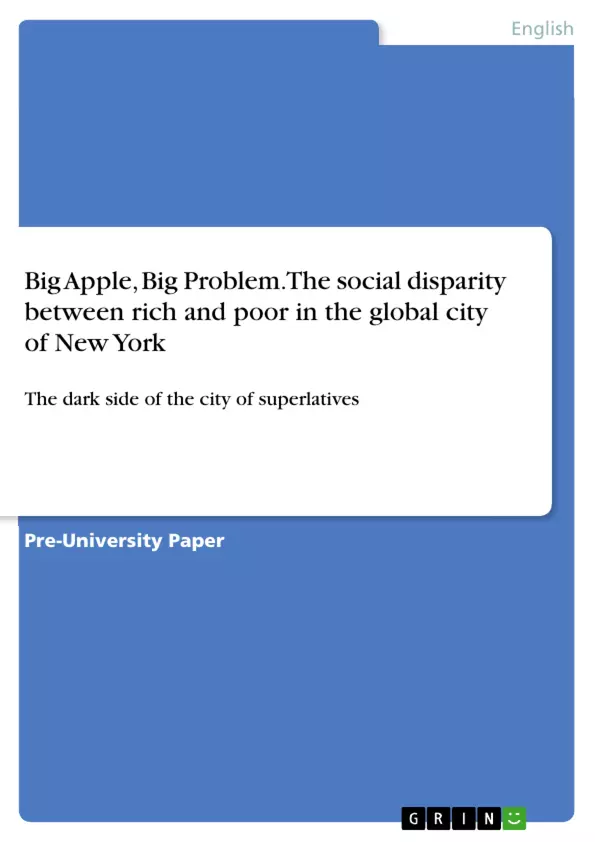The paper analyzes the growing gap between the rich and the poor in New York City, examining both historical developments and the city's spatial structure. It also looks at population trends and the division of society into different social classes – the upper class, middle class, and lower class – highlighting key issues such as gentrification, homelessness, and crime.
The author investigates the causes of these social disparities and their impact on urban life. Rising living costs, housing shortages, and unequal economic opportunities have led to an increasing divide between wealthy and poor residents. Additionally, the paper discusses government measures and aid programs aimed at addressing these social problems.
Drawing from various sources, the paper concludes with a critical reflection on how this social divide might evolve in the future.
Inhaltsverzeichnis (Table of Contents)
- Introduction
- Founding History
- 17th Century
- 18th Century
- 19th Century
- 20th Century
- Spatial Structure
- Manhattan
- Brooklyn
- Queens
- Bronx
- Staten Island
- Population Development
- Social Structures
- Upper Class
- Middle Class
- Underclass
- Consequences of Social Injustice
Zielsetzung und Themenschwerpunkte (Objectives and Key Themes)
This work aims to explore the significant social disparity between the rich and poor in New York City, investigating its historical roots and contemporary manifestations. The study seeks to understand how this social divide has evolved and its impact on the city's inhabitants.
- Historical development of social inequality in New York City.
- The spatial distribution of wealth and poverty across different boroughs.
- The role of historical events (e.g., colonization, immigration) in shaping social structures.
- The impact of social inequality on various aspects of life in New York City.
- The contrast between New York City's image as a city of opportunity and the reality of widespread poverty and social injustice.
Zusammenfassung der Kapitel (Chapter Summaries)
Introduction: This chapter introduces the central theme of the vast social disparity in New York City, contrasting its glamorous image with the harsh realities of poverty and homelessness. It establishes the research question: how did this divide emerge and how does it impact life in the city? The author's personal motivation for choosing this topic, stemming from a report highlighting the growing wealth of the upper class and its distance from the rest of the population, is also presented.
Founding History: This chapter traces the historical development of New York City, beginning with its discovery by Verrazano in 1524 and the subsequent Dutch colonization. It highlights the early conflicts between the Dutch settlers and the indigenous Lenni-Lenape population, and the corrupt governance and social injustices that characterized the nascent city. The chapter then progresses through the 17th, 18th, and 19th centuries, detailing key events such as the slave uprising of 1712, the city's role in the American Revolution, and the massive population growth and immigration of the 19th century. This historical overview lays the groundwork for understanding the roots of present-day social inequalities.
Schlüsselwörter (Keywords)
Social inequality, New York City, poverty, wealth disparity, historical development, social structures, urban development, immigration, colonization, social justice.
Frequently asked questions about the Language Preview
What is the purpose of this document?
This document is a comprehensive language preview for an academic work. It includes a table of contents, objectives and key themes, chapter summaries, and a list of keywords.
What is the topic of the academic work?
The academic work explores the significant social disparity between the rich and poor in New York City, investigating its historical roots and contemporary manifestations. It focuses on how this social divide has evolved and its impact on the city's inhabitants.
What are the key themes addressed in the study?
The key themes include the historical development of social inequality in New York City, the spatial distribution of wealth and poverty across different boroughs, the role of historical events in shaping social structures, the impact of social inequality on various aspects of life in New York City, and the contrast between New York City's image as a city of opportunity and the reality of widespread poverty and social injustice.
What is covered in the chapter summaries?
The chapter summaries provide an overview of the content of each chapter in the academic work. The introduction establishes the central theme and research question, while the "Founding History" chapter traces the historical development of New York City from its discovery to the 19th century, highlighting key events and their impact on social inequalities.
What historical events are discussed in the "Founding History" chapter?
The "Founding History" chapter discusses events such as the discovery of New York City by Verrazano, the Dutch colonization, conflicts between Dutch settlers and the Lenni-Lenape population, the slave uprising of 1712, New York City's role in the American Revolution, and the massive population growth and immigration of the 19th century.
What keywords are associated with this study?
The keywords associated with this study include social inequality, New York City, poverty, wealth disparity, historical development, social structures, urban development, immigration, colonization, and social justice.
What specific locations are examined in terms of spatial structure?
The study examines the spatial distribution of wealth and poverty across different boroughs including Manhattan, Brooklyn, Queens, Bronx and Staten Island.
- Arbeit zitieren
- Anonym,, 2023, Big Apple, Big Problem. The social disparity between rich and poor in the global city of New York, München, GRIN Verlag, https://www.grin.com/document/1568385



